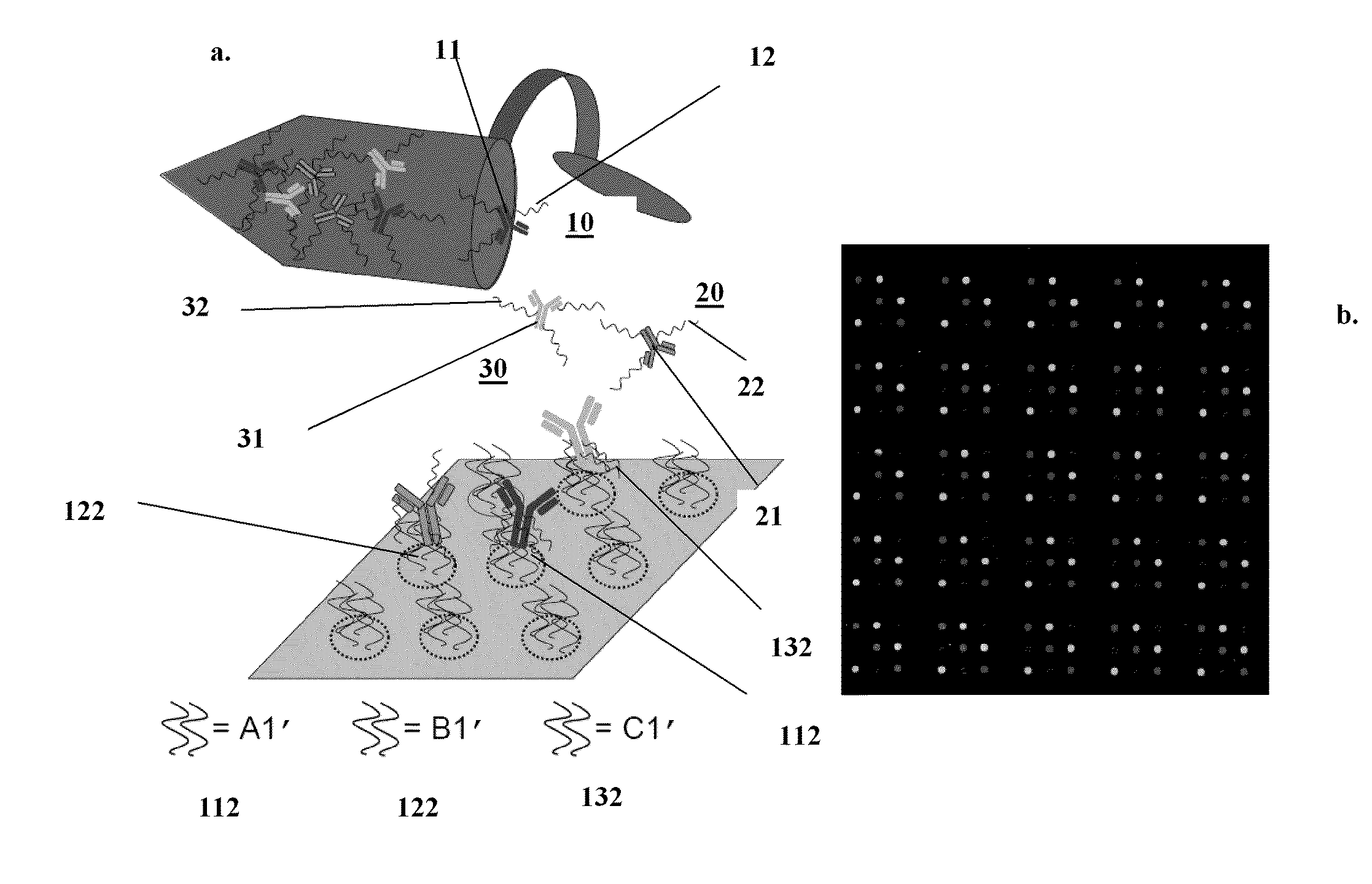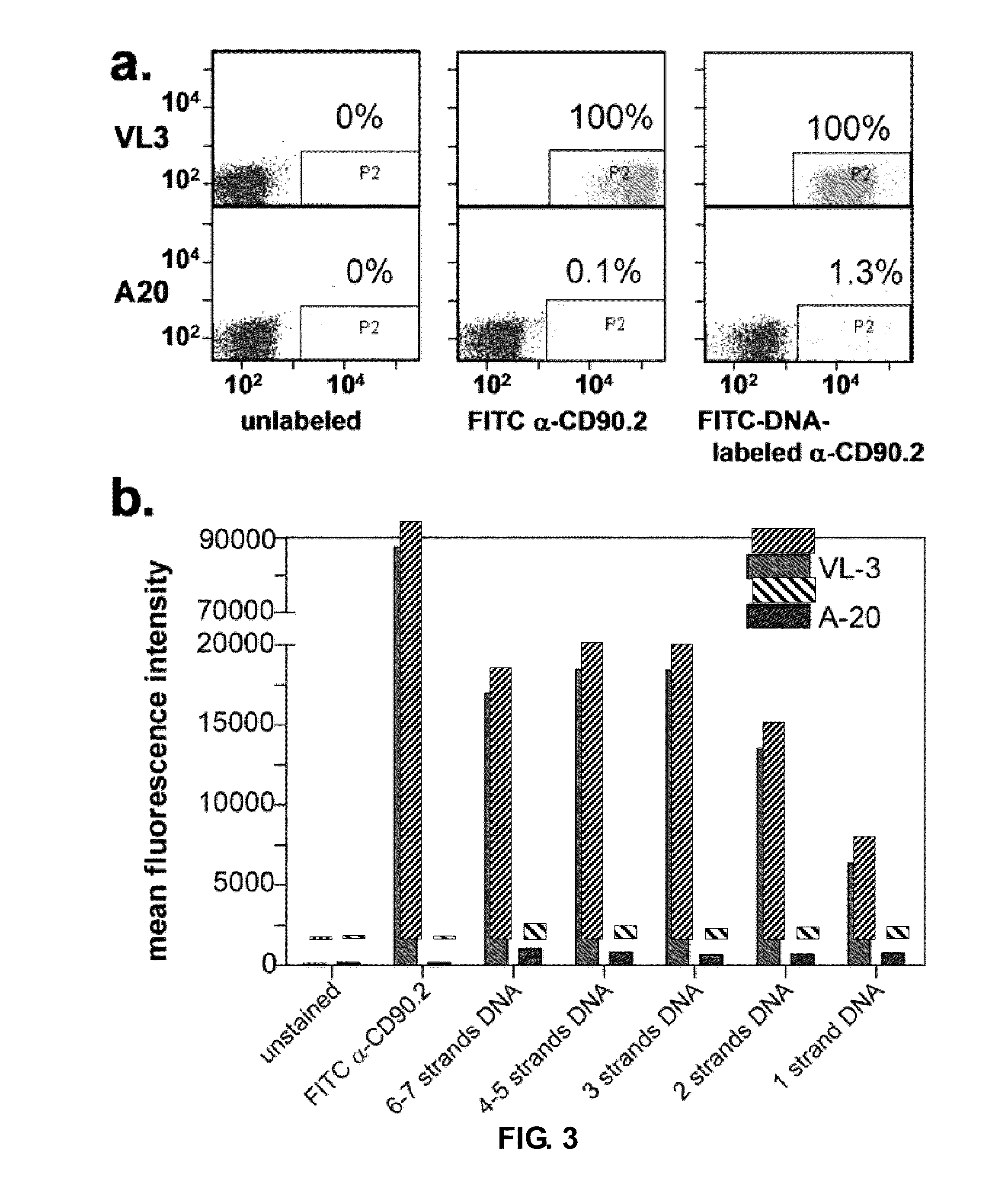Methods and systems for detecting and/or sorting targets
a target detection and target technology, applied in the field of target detection and/or target sorting, can solve the problems of high sensitivity detection of targets, affecting our molecular level understanding, and it is unlikely that single-parameter measurements will be the norm, so as to reduce biofouling, reduce size, and reduce the effect of binding efficiency
- Summary
- Abstract
- Description
- Claims
- Application Information
AI Technical Summary
Benefits of technology
Problems solved by technology
Method used
Image
Examples
example 1
Production of Polynucleotide-Encoded Antibodies
[0151]DNA encoded antibodies were generated according to the two step strategy illustrated in FIG. 1. In particular, an aldehyde functionality was introduced to the 5′-aminated oligonucleotide via succinimide chemistry, using commercially available reagents (FIG. 1 Panel a). Similarly, a hydrazide moiety was introduced via reaction with the lysine side chains of the respective antibody (FIG. 1 Panel a). DNA-antibody conjugate formation was then facilitated via stoichiometric hydrazone bond formation between the aldehyde and hydrazide functionalities. Conjugate formation and control over DNA-loading was verified by PAGE electrophoresis (FIG. 1 Panel b).
[0152]To perform those experiments, AlexaFluor 488, 594, and 647-labeled polyclonal Goat anti-Human IgGs were purchased from Invitrogen. Monoclonal Rabbit anti-Human Interleukin-4 (clone: 8D4-8), non-fluorescent and APC-labeled Rabbit anti-Human Tumor Necrosis Factor-α(clones: MAb1 and MAb...
example 2
Production of Polynucleotide-Encoded Streptavidin
[0159]The production of DNA encoded streptavidin was performed according to the same approach illustrated in Example 1 for production of DNA encoded antibodies. The only difference was that the SANH:streptavidin ratio was kept constant at 100:1.
example 3
Optimization Polynucleotides Loading Polynucleotide-Encoded Antibodies
[0160]The adverse steric effects of tagging antibodies with oligonucleotides are of concern when performing various assays, such as the immunoassays and cell sorting / capture experiments described herein. For this reason, the ability of DNA-encoded antibodies to retain recognition of cell surface markers, was investigated, as visualized by fluorescence activated cell sorting (FACS). By using a fluorophore covalently-tagged onto the DNA, but not the antibody, FACS was used to optimize DNA-loading for the polynucleotide-encoded conjugates. For the analysis, 5′ aminated, 3′ FITC-labeled DNA was tagged unto α-CD90.2 antibodies at various stoichiometric ratios of SANH to antibody (5:1, 25:1, 50:1, 100:1, 300:1). This produced, on average, conjugates with 1, 2, 3, 4-5 and 6-7 strands of FITC-DNA respectively, as measured by gel mobility shift assays see Panel d, FIG. 1. These conjugates were tested for their ability to b...
PUM
| Property | Measurement | Unit |
|---|---|---|
| temperature | aaaaa | aaaaa |
| pH | aaaaa | aaaaa |
| pH | aaaaa | aaaaa |
Abstract
Description
Claims
Application Information
 Login to View More
Login to View More - R&D
- Intellectual Property
- Life Sciences
- Materials
- Tech Scout
- Unparalleled Data Quality
- Higher Quality Content
- 60% Fewer Hallucinations
Browse by: Latest US Patents, China's latest patents, Technical Efficacy Thesaurus, Application Domain, Technology Topic, Popular Technical Reports.
© 2025 PatSnap. All rights reserved.Legal|Privacy policy|Modern Slavery Act Transparency Statement|Sitemap|About US| Contact US: help@patsnap.com



